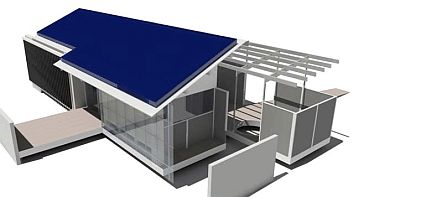
A house that is powered entirely by the energy from the sun is on every environmentalist’s wish list. Teams from 20 universities are busy creating solar homes for the Department of Energy’s 2007 Solar Decathlon. All the houses will be on display for ten days in October at the National Mall in Washington D.C.
A team from MIT is developing a solar home dubbed the MIT Solar 7 (named because it is the seventh solar home built by MIT since 1939). The MIT Solar 7 will be a 800-square-foot home, that will incorporate energy-efficient design and the latest in solar technology. The team will make use of a passive solar-heating system and a photovoltaic array that is big enough to not only power a house but also an electric car.
The competition is not to test new solar technologies, but to make use of technologies that are commercially available. To keep the norms of the competition the team is using energy-efficient windows originally developed at MIT that use krypton gas as an insulator between three panes of glass.
To keep the house warm without any external heating source the team has made use of thermal mass-material that retains heat from sunlight. MITs home will use wall made of 1-foot-thick multi-layered tiles that will hold water and an insulator known as aerogel. This wall will hold 60 gallons of water and aerogel, which will enable it to retain heat and cold air while letting in light.
The south-facing wall will contain 60 evacuated tubes to heat water that is circulated in between these tubes. During the installation on the National Mall, participants will be judged on how well their house performs by hosting a dinner party and doing loads of laundry with solar heated water.
The team will be using a 9-kilowatt solar array that will charge 24 batteries capable of holding 70 kilowatt-hours of power. This will be enough to run the home in the absence of sun and will be recharged in two days.
The excess power will then be used to power an electric car. When complete the building will be wired by sensors to measure the fluctuations in temperature in a way to judge the building’s heat-efficiency.
Good architectural design will also be of importance in designing a perfect home, the house has to be disassembled and then reassembled at the National Mall and so the team will be using screws instead of nails to hold the house together. Moreover, a perfect design could reduce the amount of energy required to run the house, making things easier for the developers. The roof of the house will maximize the amount of daylight that comes in thereby cutting down on the electricity requirements at the same time the roof will be angled to prevent light from entering the house during the hottest part of the day.
The team is also planning a water-reclamation system that will be storing the runoff water that can be used for landscaping. The team is also hoping to sell the final home as a way to create funds for MIT’s entry in the next Solar Decathlon competition in two years.
Via: CNET




